KEY DIFFERENCES BETWEEN PRUNING PEAR TREES AND APPLE TREES
There are two key differences between apple and pear trees which need to be taken into account when pruning a pear tree. The primary difference is that pear trees will grow far more upright compared to an apple tree. The branches want to reach for the sky in their search for light. In order to encourage early and large amounts of fruit this tendency to grow upright needs to be managed.
The second difference is that pear tree wood is relatively soft compared to apple wood and it is more likely to break under the weight of a full crop of fruit. This weakness needs to be considered when pruning.
EQUIPMENT NEEDED TO PRUNE PEAR TREES
The equipment needed to prune a pear tree depends on how thick the branches are and how high the tree is. Three pieces of basic ‘equipment’ though are always needed and these are:
- Secateurs – these must be sharp to avoid crushing rather than cutting cleanly any stems and small branches. Before cutting in earnest, try out your secateurs on a redundant piece of wood to make sure they cut cleanly. If they don’t then buy a new pair or get the old ones sharpened (difficult nowadays). Clean your secateurs thoroughly to ensure they don’t transfer any disease, pest or spores. Boring but very important especially when working on more than one tree – clean between pruning different trees. To clean, wash them thoroughly in soapy water, clean them again with bleach, rinse thoroughly under running water and then dry off with a cloth.
- Knowledge and time – knowledge can be gained by reading this article thoroughly before you start. As far as time goes, a new one year old tree can be pruned in five minutes, but an old overgrown tree may take several hours and this may well need to be spread over three or four years.
- A dry day – not really equipment but pruning should always be done on a dry day. If you cut stems and branches on a wet day the risk of infection entering the cuts is much increased. The British weather is not always the best for pruning in winter but there will be dry days and it’s best to wait for one of them.
The above equipment will be sufficient to prune most pear trees up to three or four years old but when the branches begin to thicken and the height of the tree increases the following additional equipment will also be needed:
- Pruning saw or carpenter’s saw. Either will do the job, the choice is up to you. We would go for a pruning saw because they are specifically designed for the purpose but they are more expensive.
- A ladder – if the tree is tall then a ladder is essential. It’s always safest to cut a branch when you are at the correct height and it’s also likely to produce the cleanest cut. Without going into all the safety aspects of using ladders, at least make sure it is on flat, even ground and is securely tied to a strong branch on the tree.
- Chalk (optional) – if a tree is particularly overgrown and out of control it’s often best to mark the main branches to be cut with a piece of chalk at the point of the proposed cut. Then stand back( after getting off the ladder of course!) and consider if the proposed cuts are really as you want.
WHEN TO PRUNE PEAR TREES
For most pear trees the best time to prune is in mid winter to very early spring. If you prune too early the tree may respond by sending out lots of tender shoots which will be severely damaged by frosts. These will then provide an ideal entry site for a variety of bacteria, fungi and pests.
New bare-rooted trees will be supplied from November to March and these should be pruned immediately after they are planted – see the section Pruning Newly Planted Pear Trees below.
THE EFFECTS OF WINTER PRUNING
When a pear tree goes dormant in the winter, nutrients and energy is stored primarily in the roots, main trunk and to a lesser degree the main large branches. Almost no energy is stored in the smaller branches. The diagram below, before pruning occurs in January, shows this more clearly. The dark pink area shows the major energy reserves and the lighter pink areas show less concentrated reserves.

In spring when the tree comes out of dormancy the natural response is to produce new growth in areas where pruning has occurred during the winter. This growth response is concentrated in areas where the tree has been pruned. The diagram below showing the energy reserves in mid April time illustrates the effect on a tree which has been severely pruned in one area only.
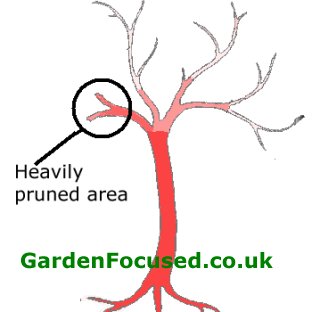
The heavily pruned area receives a higher than normal amount of the energy reserves which causes the tree to produce lots of new green growth in that area. This also has the effect of delaying the production of fruit. Note that this effect is localised and generally does not affect parts of the tree which have not been heavily pruned.
To summarise the effect of winter pruning, it increases the growth of branches and foliage in the next two years and at the same time delays the production of fruit. If done carefully however it can improve the shape and structure of the tree allowing heavier crops in later years.
COMMON SHAPES OF PEAR TREES
The most common shape of a pear tree (for the amateur gardener) is an open-centred one where the main leader has been pruned out and four or so main branches grow evenly spaced from the centre. See the picture below of a young tree with four side branches but the main stem (the leader) has been pruned away. Click the picture to enlarge it.
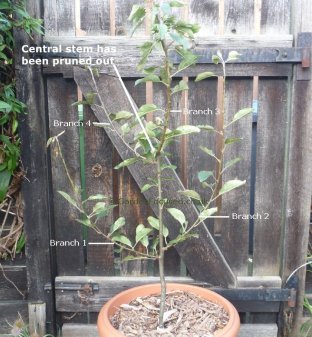
Another shape, more commonly found in some orchards is the central leader tree shape. With this shape the central leader is allowed to grow and three branches are allowed to form at at about 75cm / 30ins above grown level followed by another layer 50cm / 20ins higher and then another layer 50cm / 20ins above that. We suggest that the previous method is probably the best for the amateur gardener.
IMPORTANCE OF FRUITING SPURS ON PEAR TREES
When pruning a pear tree it’s important to be able to identify what are called “fruiting spurs” because this is where the fruit will form. If you prune off fruiting spurs you are effectively reducing the capability of the tree to produce fruit for a year or two. See the picture below (click to enlarge it) for an example of a fruiting spur. Do not prune off fruiting spurs unless they are on a branch you want to get rid of or the area is becoming congested with older fruiting spurs.
Fruiting spurs will normally appear on stems which were originally grown two years previously. They can appear anywhere on the branches. They will take a year, occasionally two, before they begin to bear fruit. The year after fruiting another one or two fruit buds will begin to appear. The picture above shows a fruiting spur with two fruit buds on it but they can grow and form many fruit buds.
After six or seven years a fruiting spur will begin to become congested with fruit buds and also the cropping capability will decline. At this stage it’s best to gradually start pruning off older fruiting spurs which will encourage new, healthy ones to appear elsewhere.
SUMMER PRUNING OF PEAR TREES
Summer pruning of pear trees is normally reserved for espaliers and cordon shaped trees but it can also be used to force a pear tree into bearing fruit if it is reluctant to do so. The normal reason for a pear tree not flowering and bearing fruit is that it is growing in perfect conditions! If you get the soil nutrients on the high side side, correct moisture levels, a good loam type soil and the tree is growing in full sun all day it will in all probability take a year or two longer to bear fruit compared to a tree which is in less ideal conditions.
To encourage a pear tree to bear fruit you need to encourage it to produce fruiting spurs. To do this lightly prune the current year’s growth by a quarter to a third, do not prune older wood at all in summer. The best time to summer prune a pear tree is in early to mid June time, never prune between mid July to late November.
What you are doing by summer-pruning is reducing the tree’s ability to store energy because it has fewer vigorous branches with lots of leaves on them to absorb the energy of the sun. If summer pruning is done around June time the tree will not produce new vegetative growth because it can detect that daylight hours will soon be reducing and autumn is only a few months ahead. Instead it will put much more of its energy into producing fruiting spurs which will bear fruit the next year.
HOW TO PRUNE YOUNG PEAR TREES
This section describes how to prune pear trees in the first two years. If your pear tree is older than this click here for details on pruning older pear trees.
PRUNING A ONE YEAR OLD PEAR TREE
This section deals with pruning a pear tree which you have recently bought and planted. First decide if the tree is a one year old or a two year old. This should be made clear to you when you bought the tree or on the labels that come with it. If you don’t know, then as a rule of thumb a one year old tree will have less than six side branches, normally two or three. A two year old tree will have five or more side branches. Read the instructions which came with the tree and follow their guidelines.
Prune a new one year old pear tree in winter after it has been planted. Normally the tree will be about 150cm / 5ft tall but this varies. With the tree planted you should cut it to a height of 90cm / 3ft above ground. This may sound harsh but this then allows the tree to put all its energy into producing branches at the correct height. Make the cut just above a bud and slant the cut so that any water settling on the top will run away from the bud.
Tidy up the tree by cutting back any branches to about 5cm / 2in. That’s it for a one year old tree.
PRUNING A TWO YEAR OLD PEAR TREE
A two year old pear tree should have previously been pruned as detailed above when it was a one year old. This applies to two year old new bare-rooted or container grown trees as well as those already growing in your own garden.
The pruning used for a two year old tree is important because it will define the base structure of the tree for the rest of its life. Although we show you a real life tree in this section every one will be different. Understand the overall objective behind this stage of pruning and you can apply it to almost any pear tree which has been correctly pruned at year one.
- Four main branches – prune so that you have three to five main branches coming off the central trunk. If you have more than this the tree structure will become crowded. If you have less the tree will find it difficult grow in a balanced fashion.
- Even spacing around the main trunk – aim to have the main branches evenly spaced around the tree. If for instance you have four main branches they should be pointing left, right, forwards and backwards. It will be unlikely that this can be done exactly but try to select main branches which fit this criteria best. It’s at this stage that you may decide three main branches is best to achieve a balance around the tree.
- Correct spacing up the main trunk – ideally you want to aim for branches which are spaced about 10cm / 4 in apart up the trunk. Keep the lowest branch at least 75cm / 2ft 6in above ground level, slightly higher is best. Again, this is the ideal but with most trees a compromise will be required.
- Main branches should be pointing outwards not upwards – pear trees are renowned for having branches which want to grow vertically. If any of the main branches grows almost vertically it will cause crowding of the centre of the tree, something definitely to be avoided. Pear tree wood is relatively soft and easily broken by heavy crops. Branches which are at an angle of about 60° to the main stem (see pictures below) are far stronger than branches which grow almost vertically.

The angle between the main trunk and the branch is ideal in the picture above.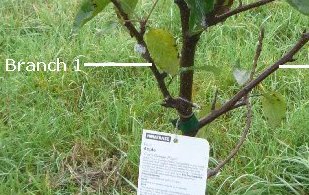
The angle of branch 1 in the picture above is too narrow and vertical. If a main branch is growing nearly vertically it needs to be pruned to an outward facing bud – the cut needs to be made fairly near the main trunk to force the branch to grow outwards and not upwards
Remember, the description above is the ideal and almost all pear trees will need some compromise.
PRUNING OLDER PEAR TREES
When pear trees get beyond three years old each tree is sufficiently unique in its own right to make specific advice about pruning very difficult. Differences in the variety, previous pruning history and environmental conditions all give rise to different tree shapes. However, the same general principles apply to pruning all established pear trees. Those principles are:
- Avoid pruning out fruiting spurs – if you examine a pear tree structure in winter, when there is no foliage, you will be able to see the difference between the current year’s stem growth and older growth. You will also be able to identify fruiting spurs (stems from which fruit will be produced in the summer). To maximise fruit production do not prune the fruiting spurs unless they become congested or diseased. See the section above on fruiting spurs for an explanation and clear picture.
- Aim for a wine glass shape – the basic idea is to encourage branches to point outwards from the main trunk. The reason for this is to keep the central part of the tree relatively free from growth allowing good air circulation and reducing the risk of fungal infections.
- Prune in gentle stages – if you hard prune a pear tree it will fight back the next spring with a vengeance, especially well established trees! Their reaction will be to sprout small stems especially from areas which have been cut back hard. These groups of small stems are almost certainly unproductive as far as as fruit is concerned and the area will become congested. If you are faced with an overgrown tree then spread cutting it back over at least two years, preferably three or four years
- Remove crossing and touching branches – where two branches cross each other, natural movement from wind will cause the branches to rub together and open up the bark to infections. Remove one of the crossing branches to prevent this.
- Remove diseased wood – whilst pruning a pear tree keep a look out for diseased wood. This should always be removed and cut back into healthy wood. Burn the diseased wood.
- Clean up afterwards – fallen branches and fruit, leaves and any other debris should be cleared away from the base of the tree. If left they provide a breeding found for fungal diseases and a variety of pests.
- Enjoy and learn from the experience – many books and web articles on this subject profess to offer perfect solutions to keeping your pear tree in check. In reality every pear tree is different from every other one and your experience from past years should be your guide.
COMMENTS / QUESTIONS LEFT BY OUR READERS
| Date: 27 February 2021 | From: Cath D |
| QUESTION: : I have a 14 year old pear tree which has been neglected and has grown a strong competing leader from the base of the main trunk. This leader is taller (about 12 ft) and thicker than the main trunk. All parts of the tree bore fruit last year I think but I didn’t compare the quality. The main original trunk has a healed, but deep, wound on its trunk too. What should I do?
ANSWER: As far as the competing leader is concerned it sounds as though it has grown from the rootstock. See the picture below: http://gardenfocused.co.uk/images/vegetables-fruit/plum/rootstock.jpg You will see the base of the tree is made up of three sections, the lowest is the rootstock, the middle bit is the join and the top bit is the scion. If the rootstock sprouts, the resulting growth will tend to be very strong and dominant. It will produce pears but they will not be the variety that you want. As soon as you see a shoot emerging from the rootstock, cut it off as close to the main stem as possible. If the wound on the original trunk has healed, leave it alone. |
|
| Date: 06 August 2019 | From: Fred L |
| QUESTION: : I have a large pear tree that’s been neglected for many years and produces little fruit but even that is poor shape and quality. What options are there to remedy or is it likely to be too late and I should put it out of its misery?
ANSWER: The answer depends on many factors. First, a well pruned pear tree can be expected to be productive for 20 to 25 years, it will live longer but fruit production will tail off significantly. A neglected pear tree will have a shorter productive life. That may answer your question if you have a rough idea of the age of the tree. Neglected pear trees can be hard pruned (in stages over a three year time span). This may well rejuvenate it although it’s by no means guaranteed. It will take a total of 4 to 5 years after the first year’s prune before it recovers. A newly bought one or two year old pear tree will take about 3 years to begin producing fruit. In 5 years from purchasing it, it will be producing fruit to its full ability. Everyone has their own view on this type of question, my personal view is that the effort expended in (hopefully) rejuvenating a neglected fruit tree is rarely worth the effort. Buy a new one is my advice, others may advise differently. |
|
| Date: 08 February 2015 | From: John |
| QUESTION: I planted myself an orchard last winter including 2 conference pears and this is the first time they will have been pruned, they were 2 Y Olds when bought, so more like 3 YO now. I bought the biggest healthiest ones I could find and so have 5 good thick branches on them but are almost vertical in a champagne glass shape rather than a wine glass and were all lobbed off level at about 7 feet high. Do I have to prune the branches close to the trunk or could I put some “stretchers” in to train them to grow outwards more horizontally.
ANSWER: Yes you can, the idea works very well with pear trees. In fact one of my trees is being persuaded to grow more horizontal branches just like that for the last couple of months. It does seem to take about six months to have a lasting effect but it works well. I use nothing more complicated than string looped around the branches weighted down with stones. Be careful though that the bark of the stems is not damaged by the string – padding at the point of contact will help to avoid that. |
|
WHY NOT LEAVE YOUR QUESTION / COMMENTS ABOUT THIS PAGE?
ENTER THEM BELOW. EMAIL ADDRESS IS OPTIONAL.
YOUR COMMENTS WILL BE ADDED ABOVE WITHIN A FEW HOURS.
[contact-form-7 id=”1882″ title=”Contact form 1″]
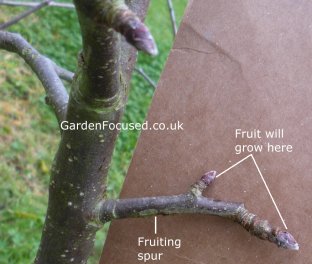
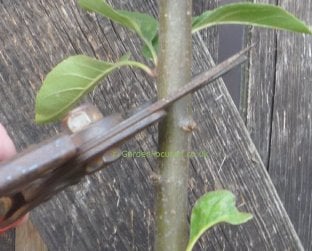
Rootstocks and Size
Guide to Pollination
Planting
Care Plan
Pruning Pear Trees
Harvest and Storage
Pests and Disease
Top ten pear varieties
Buying – Price Comparison
PRUNING PEAR TREES IN THE UK
By David Marks
Pruning pear and apple trees is a task which is often grouped together and while there are many similarities there are also a few key differences between these two types of fruit trees. This article is devoted exclusively to pear trees and how best to prune them.
We describe how to prune for the most common bush tree shape and explain briefly how to prune a pear tree with a central leader.